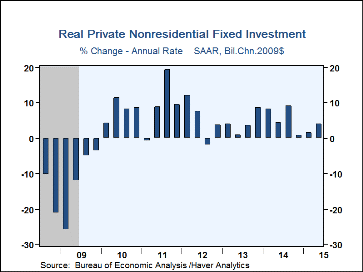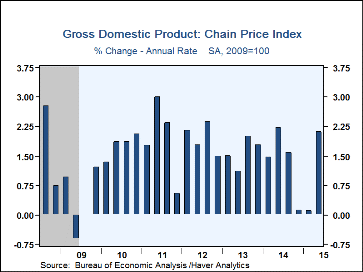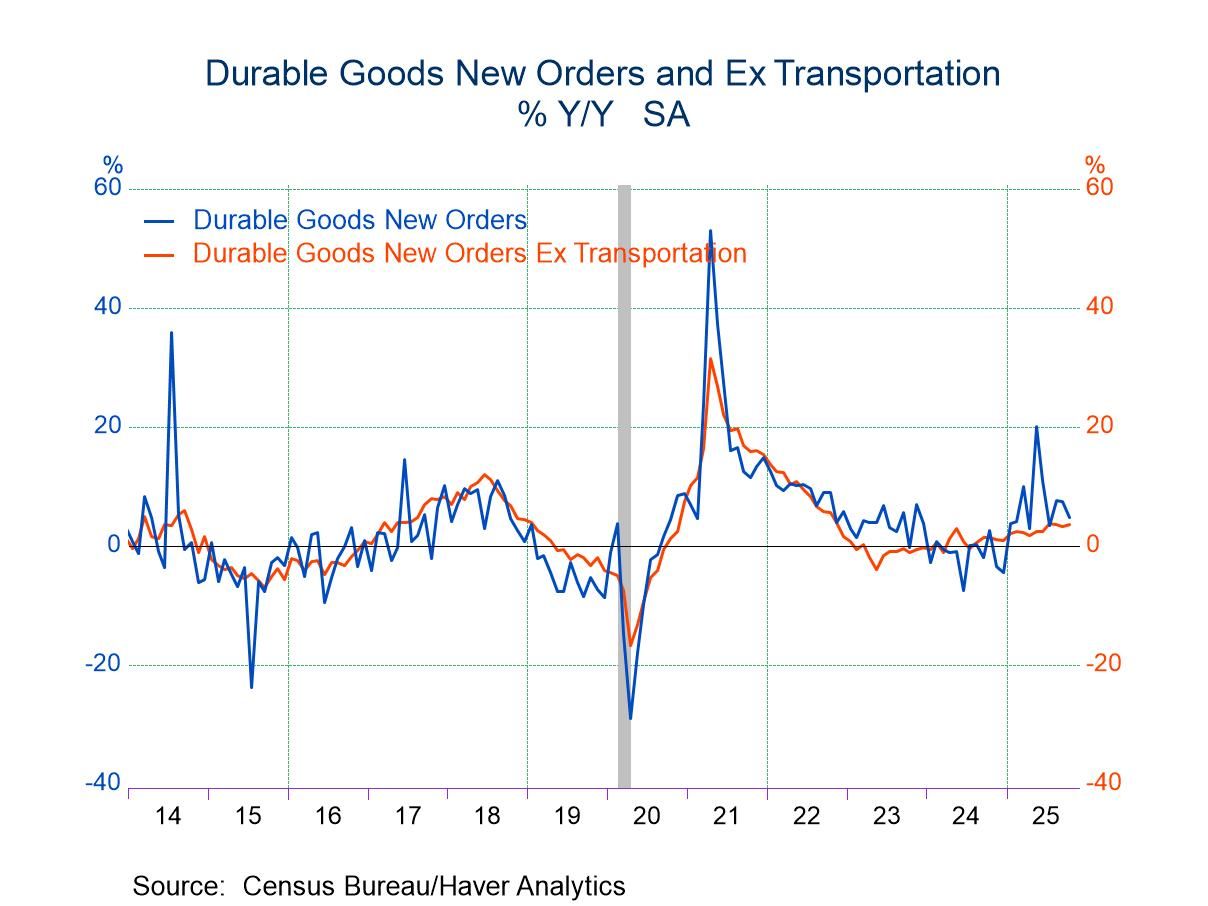 Global| Sep 25 2015
Global| Sep 25 2015U.S. GDP Growth Is Revised Up as Final Demand Strengthens
by:Tom Moeller
|in:Economy in Brief
Summary
Real economic activity grew at a revised 3.9% annual rate in the second quarter (2.7% y/y) versus last month's estimate of 3.7% and the initial estimate of a 2.3% rise. This compares to a 0.6% Q1 advance, which was restrained by [...]
Real economic activity grew at a revised 3.9% annual rate in the second quarter (2.7% y/y) versus last month's estimate of 3.7% and the initial estimate of a 2.3% rise. This compares to a 0.6% Q1 advance, which was restrained by severe winter weather and West coast port closings. The latest estimate outpaced consensus expectations for an unchanged 3.7% rise in the Action Economics Forecast Survey.
Domestic final sales grew at a 3.7% rate, revised from 3.2%. Consumer spending advanced at a 3.6% pace, revised from 3.1%. The revision reflected a quickened 2.7% advance (3.0% y/y) in services purchases due to strength in food services & accommodations, transportation and health care. Motor vehicle purchases improved at a lessened 9.7% rate. Furnishings & household equipment buying grew at an unrevised 4.6% rate. Apparel spending rose at a little-revised 6.6% rate. Food & beverage purchases grew 2.7% following declines in each of the prior four quarters.
Business fixed investment growth was raised to 4.1% from 3.2%. Growth in structures investment was doubled to 6.3%. It recovered from a 7.4% Q1 decline. Growth in equipment spending was raised to 0.3% from -0.4%. Declines in information processing investment and transportation equipment spending were sustained; and investment in intellectual property products grew a little-changed 8.3%. Spending on research and development jumped 12.5%.
Residential fixed investment growth was raised to 9.4% from 7.8%, continuing a stretch of five quarters of firm gain.
Government spending growth was unrevised at 2.6%. State & local spending increased 4.3% (1.4% y/y), rebounding after a 0.8% shortfall. Federal government purchases were unchanged (-3.3% y/y) after a 1.1% rise, held back by a 0.5% decline (+1.3% y/y) in nondefense purchases. Defense spending grew 0.3% (-1.3% y/y).
The contribution to GDP growth from inventory investment was left the same at 0.2 percentage points. That was down from a 0.9 point Q1 addition. Foreign trade added an unchanged 0.2 percentage points to GDP growth as exports grew 5.1% and outpaced the 3.0% gain in imports.
After-tax corporate profits grew 6.3% (8.5% y/y), up from 5.1% reported initially and the strongest gain since Q1 2012. Financial industry profits grew 9.6% (-1.7% y/y) and nonfinancial sector earnings improved 1.9% (1.8% y/y). Earnings from the rest of the world rose 2.9% (-0.9% y/y), revised from a moderate decline.
The GDP price index advanced at an unrevised 2.1% rate. The personal consumption price index rose 2.2% and the index less food & energy increased 1.9%. The business fixed investment price index fell at a 1.0% rate (+0.1% y/y) while the residential price index declined 0.8% (+2.5% y/y).
The GDP figures can be found in Haver's USECON and USNA databases; USNA contains virtually all of the Bureau of Economic Analysis' detail in the national accounts, including the integrated economic accounts and the recently added GDP data for U.S. Territories. The Action Economics consensus estimates can be found in AS1REPNA.
Inflation Dynamics and Monetary Policy is the title of yesterday's speech by Fed Chair Janet L. Yellen and it can be found here.
| Chained 2009 $ (%, AR) | Q2'15 (3rd Estimate) | Q2'15 (2nd Estimate) | Q2'15 (Initial Estimate) | Q1'15 | Q4'14 | Q2 Y/Y | 2014 | 2013 | 2012 |
|---|---|---|---|---|---|---|---|---|---|
| Gross Domestic Product | 3.9 | 3.7 | 2.3 | 0.6 | 2.1 | 2.7 | 2.4 | 1.5 | 2.3 |
| Inventory Effect | 0.2 | 0.2 | -0.1 | 0.9 | -0.0 | 0.3 | 0.0 | 0.1 | 0.2 |
| Final Sales | 3.9 | 3.5 | 2.4 | -0.2 | 2.1 | 2.5 | 2.4 | 1.4 | 2.1 |
| Foreign Trade Effect | 0.2 | 0.2 | 0.1 | -1.9 | -0.9 | -0.5 | -0.1 | 0.2 | 0.2 |
| Domestic Final Sales | 3.7 | 3.2 | 2.2 | 1.7 | 3.0 | 3.0 | 2.5 | 1.2 | 1.9 |
| Demand Components | |||||||||
| Personal Consumption Expenditures | 3.6 | 3.1 | 2.9 | 1.7 | 4.3 | 3.3 | 2.7 | 1.7 | 1.5 |
| Business Fixed Investment | 4.1 | 3.2 | -0.6 | 1.6 | 0.7 | 3.8 | 6.2 | 3.0 | 9.0 |
| Residential Investment | 9.4 | 7.8 | 6.6 | 10.1 | 9.9 | 8.2 | 1.8 | 9.5 | 13.5 |
| Government Spending | 2.6 | 2.6 | 0.8 | -0.1 | -1.4 | 0.7 | -0.6 | -2.9 | -1.9 |
| Chain-Type Price Index | |||||||||
| GDP | 2.1 | 2.1 | 2.0 | 0.1 | 0.1 | 1.0 | 1.6 | 1.6 | 1.8 |
| Personal Consumption Expenditures | 2.2 | 2.2 | 2.2 | -1.9 | -0.4 | 0.2 | 1.4 | 1.4 | 1.8 |
| Less Food/Energy | 1.9 | 1.8 | 1.8 | 1.0 | 1.0 | 1.3 | 1.5 | 1.5 | 1.9 |
Tom Moeller
AuthorMore in Author Profile »Prior to joining Haver Analytics in 2000, Mr. Moeller worked as the Economist at Chancellor Capital Management from 1985 to 1999. There, he developed comprehensive economic forecasts and interpreted economic data for equity and fixed income portfolio managers. Also at Chancellor, Mr. Moeller worked as an equity analyst and was responsible for researching and rating companies in the economically sensitive automobile and housing industries for investment in Chancellor’s equity portfolio. Prior to joining Chancellor, Mr. Moeller was an Economist at Citibank from 1979 to 1984. He also analyzed pricing behavior in the metals industry for the Council on Wage and Price Stability in Washington, D.C. In 1999, Mr. Moeller received the award for most accurate forecast from the Forecasters' Club of New York. From 1990 to 1992 he was President of the New York Association for Business Economists. Mr. Moeller earned an M.B.A. in Finance from Fordham University, where he graduated in 1987. He holds a Bachelor of Arts in Economics from George Washington University.












